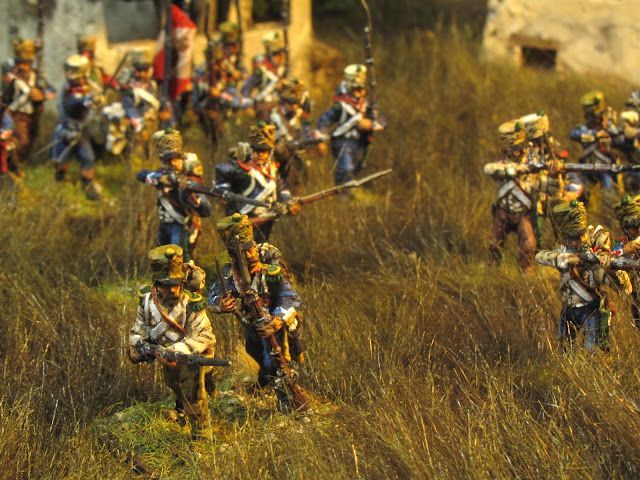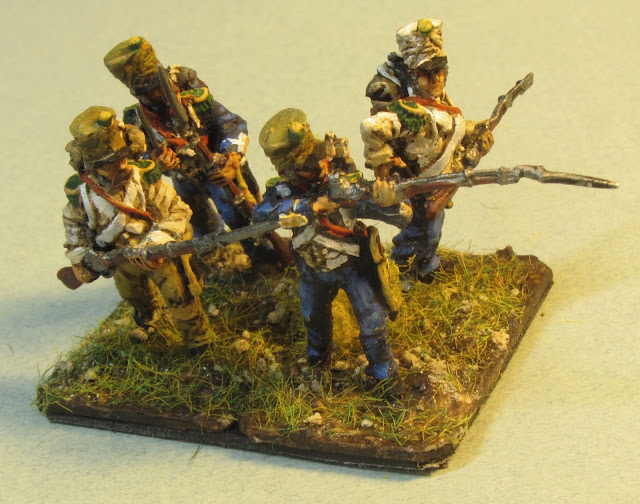 |
| The commanding officer of the 16th Lègére cautiously sends out his skirmish line. |
One of my acquisitions from 52nd Black Watch last winter were two sets of their Spanish Light Infantry in Spain, enough to do a six stand battalion totalling 24 figures. As always, these are beautiful sculpts in metal, a nice departure from my mostly all-plastic armies.
They are identified as the 31st Lègére, mainly because they are all sculpted without jackets (with the exception of the officer and drummer), wearing instead just their long-sleeved white vests as depicted in an image by El Guil. I had originally planned to paint them up as the 31st, but decided instead to go with the 16th, a regiment that also saw extensive action in Spain.
 As much as I liked the idea of the long-sleeved white waistcoats I also felt that if I painted them all that way they wouldn’t necessarily integrate that well with the rest of my light infantry (they weren’t going to integrate well, regardless, as the Black Watch sculpts are quite differently proportioned from the slender HaT sculpts). So I decided to put most of them into the long-tailed jacket, leaving only a few in shirt sleeves. I hope the sculptor will forgive me!
As much as I liked the idea of the long-sleeved white waistcoats I also felt that if I painted them all that way they wouldn’t necessarily integrate that well with the rest of my light infantry (they weren’t going to integrate well, regardless, as the Black Watch sculpts are quite differently proportioned from the slender HaT sculpts). So I decided to put most of them into the long-tailed jacket, leaving only a few in shirt sleeves. I hope the sculptor will forgive me!
 |
| After starting to paint these I decided to add coattails to 14 of the figures so they would look a but more like the rest of my light infantry. |
Beyond that my only conversions were to make the extra drummer into a flag bearer (a fanion, as the light infantry in Spain had been directed to leave their Eagles at the depot) and a slight alteration to the second officer, placed on my grenadier stand, so he wouldn't look identical to the first.
A bit of history
The 16th light demi-brigade was formed in 1796. It served in the armies of the Rhine, Germany, Helvetia, Naples and Italy.
The 16th Lègére also had a long history in the Peninsula, a small contingent entering into Spain as part of the Corps d'Observation de la Gironde sent in to support Spain in its war against Portugal in 1801 and returning to France in 1802.
The 16th Lègére (first three battalions) joined Marshal Victor’s 1st Corps, in Lapisse’ 2nd Division. They fought on the French right, helping defeat and disperse Blake’s Spanish army before joining Napoleon on the march to Madrid.
They later fought at Talavera in July 1809, where General Lapisse was killed, and then spent most of the next few years with Victor in the endless siege of Cadiz. By 1813 only the 1st Battalion was left in Spain, present at the battle of Vittoria and the subsequent withdrawal of the French forces from the Peninsula.
This excellently researched French site has loads more information on the 16th Lègére.
http://frederic.berjaud.free.fr/Articles_de_Didier_Davin/16eLeger/16eme_leger.htm
And here are a few photos of my results:
 |
| The flag bearer is a conversion from the drummer behind. I gave him a fanion as by this point in the war light infantry battalions had been instructed to not bring their Eagles onto the field. |
 |
| My grenadier stand with a slightly altered commander figure serving as a grenadier lieutenant. |
 |
| This stand of voltigeurs has two of the figures in their white long-sleeved vests. Part of me wishes I had simply left the entire unit in the vests!! |











Nice figures very atmospheric photos as well
ReplyDeleteThank you, good soldier Svjek! Yes, they really are remarkable figures and a real joy to paint.
DeleteThey are very nice figures and beautifully painted Bill. I have a mix of plastic and metal myself and find I need to be much more careful with the little metal fellas. Much less forgiving when you drop them.
ReplyDeleteThanks for the kind comments. Yes, the lead can certainly snap off - a couple of figures came with broken muskets, unfortunately, but I managed to get them reattached
DeleteM
ReplyDeleteExcellent painted unit again Bill! And I see you can continue painting! That are a whole lot of figures!
ReplyDeleteGreetings
Peter
Thanks, Peter. And yes, those may keep me going for a little while... ;0)
Delete